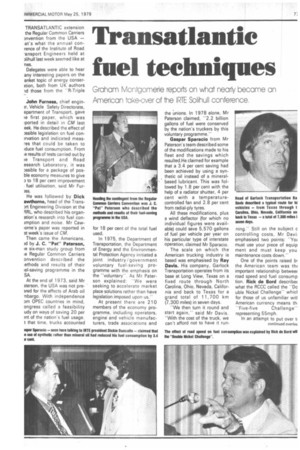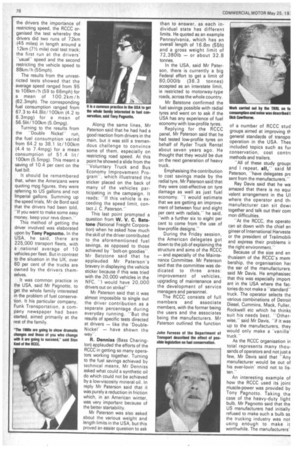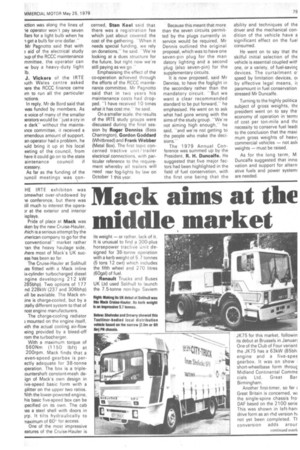Transatlantic fuel techniques
Page 79

Page 80

Page 81

If you've noticed an error in this article please click here to report it so we can fix it.
Graham Montgomerie report on what nearly became an American take-over of the IRTE Solihull conference.
TRANSATLANTIC extension the Regular Common Carriers )nvention from the USA — at's what the annual conrence of the Institute of Road 'ansport Engineers held at )1ihull last week seemed like at nes.
Delegates were able to hear any interesting papers on the anket topic of energy conserMon, both from UK authors id those from the "R-Triple
John Furness, chief engin)r, Vehicle Safety Directorate, apartment of Transport, gave ie first paper, which was :ported in detail in CM last eek. He described the effect of )ssible legislation on fuel con:rvation and indicated measres that could be taken to duce fuel consumption. From a results of tests carried out by ie Transport and Road esearch Laboratory, it was )ssible for a package of posble economy measures to give 3 to 1 8 per cent improvement fuel utilisation, said Mr Fur He was followed by Dick awthorne, head of the TransAt Engineering Division at the RRL, who described his organation's research into fuel cona-notion and noise. Mr Caworne's paper was reported in st week's issue of CM.
Then came the Americans. KI by J. C. "Pat" Paterson, le six-man study group from le Regular Common Carriers onvention described the lethods and results of their lel-saving programme in the SA.
At the end of 1973, said Mr aterson, the USA was not pre3red for the effects of Arab oil nbargo. With independence pm OPEC countries in mind, ongress called a feasibility udy on ways of saving 20 per :nt of the nation's fuel usage. t that time, trucks accounted for 18 per cent of the total fuel used.
In 1975, the Department of Transportation, the Department of Energy and the Environmental Protection Agency initiated a joint industry/government voluntary fuel-saving programme with the emphasis on the -voluntary". As Mr Paterson explained: -We were seeking to accelerate market place solutions rather than have legislation imposed upon us."
At present there are 210 members of the economy programme, including operators, engine and vehicle manufacturers, trade associations and
the Unions. In 1978 alone, Mr Paterson claimed, "2.2 billion gallons of fuel were conserved by the nation's truckers by this voluntary programme," Gaspar Sparacio from Mr Paterson's team described some of the modifications made to his fleet and the savings which resulted.He claimed for example that a 3.4 per cent saving had been achieved by using a synthetic oil instead of a mineralbased lubricant. This was followed by 1.8 per cent with the help of a radiator shutter, 4 per cent with a temperaturecontrolled fan and 2.8 per cent from radial-ply tyres.
All these modifications, plus a wind deflector (for which no individual figures were available) could save 5,570 gallons of fuel per vehicle per year on his particular type of interstate operation, claimed Mr Sparacio.
The scale on which the American trucking industry is based was emphasised by Ray Davis. His company, Garlock Transportation operates from its base at Long View, Texas on a fixed route through North Carolina, Ohio, Nevada, California and back to Texas for a grand total of 11,700 km (7,300 miles) in seven days.
"We then turn it round and start again," said Mr Davis. "With the cost of the truck, we can't afford not to have it run fling." Still on the subject e controlling costs, Mr Davi emphasised two points: "Yoi must use your piece of equip ment and must keep you maintenance costs down."
One of the points raised bl the American team was thi important relationship betweet road speed and fuel consump tion. Rick de fiord describe( what the RCCC called the "Do uble Nickel Challenge" whicl for those of us unfamiliar witl American currency means till "Five-five Challenge" representing 55mph.
In an attempt to put over tl the drivers the importance of restricting speed, the RCCC organised the test whereby the drivers did two runs of 72km .(45 miles) in length around a 12km (71/2 mile) oval test track; the first run at the drivers' "usual" speed and the second restricting the vehicle speed to 88km/h (55mph).
The results from the unrestricted tests showed that the average speed ranged from 95 to 106km/h (59 to 66mph) for a mean of 100.2km /h (62.3mph). The corresponding fuel consumption ranged from 67.3 to 44.8Iit/ 100km (4.2 to 6.3mpg) for a mean of 56.5Iit/ 100km (5.0mpg).
Turning to the results from the "Double Nickelrun, the fuel consumption varied from 64.2 to 38.1 lit/100km (4.4 to 7.4mpg) for a mean consumption of 51.4 lit / 100km (5.5mpg). This meant a saving of 10.4 per cent on the fuel bill.
It should be remembered that, when the Americans were quoting mpg figures, they were referring to US gallons and not Imperial gallons. Summing up the speed trials, Mr de Bord said that the drivers had been told, -If you want to make some easy money, keep your revs down.
This method of getting the driver involved was elaborated upon by Tony Pagnotto. In the USA, he said, there are 225,000 transport fleets, with a national average of 10 vehicles per fleet. But in contrast to the situation in the UK, over 60 per cent of the trucks are owned by the drivers themselves.
It was common practice in the USA, said Mr Pagnotto, to get the whole family interested in the problem of fuel conservation. It his particular company, Funk Transportation, a company newspaper had been started, aimed primarily at the rest of the family.
Along the same lines, Mr Paterson said that he had had a good reaction from drivers in the main, but it was still a tremendous challenge to convince some of them, especially on restricting road speed. At this point he showed a slide from the "Voluntary Truck and Bus Economy Improvement Program", which illustrated the sticker placed on the back of many of the vehicles participating in the campaign. It reads. -If this vehicle is exceeding the speed limit, contact J. C. Paterson.
This last point prompted a question from W. V. C. Batstone (National Freight Corporation) when he asked how much the skill of the driver contributed to the aforementioned fuel savings, as opposed to those achieved by "bolt-on goodies". Mr Batstone said that he applauded Mr Paterson's bravery in displaying the vehicle sticker because if this was tried with the 20,000 vehicles in the NFC, -I would have 20,000 drivers out on strike!"' Mr Paterson said that it was almost impossible to single out the driver contribution as a separate percentage during everyday running. "But the results of specific tests directed at drivers — like the 'Doublehave shown the way-.
R. Denniss (Bass Charington) applauded the efforts of the RCCC in getting so many operators working together. Turning to the fuel savings achieved by technical means, Mr Denniss asked what could a synthetic oil do which could not be achieved by a low-viscosity mineral oil. In reply Mr Paterson said that it was purely a reduction in friction which, in an American winter, was very important because of the better startability.
Mr Paterson was also asked about the various weight and length limits in the USA, but this proved an easier question to ask than to answer, as each individual state has different limits. He quoted as an example Pennsylvania, which has an overall length of 16.8m (55ft) and a gross weight limit of 72,380lb — or about 32.8 tonnes.
In the USA, said Mr Paterson, there is currently a big Federal effort to get a limit of 80,000lb (36.3 tonnes) accepted as an interstate limit, ie restricted to motorway-type roads, across the whole country.
Mr Batstone confirmed the fuel savings possible with radial tyres and went on to ask if the USA has any experience of fuel economy with low-profile tyres.
Replying for the RCCC panel, Mr Paterson said that he had tested low-profile tyres on behalf of Ryder Truck Rental about seven years ago. He thought that they would be due on the next generation of heavy truck.
Emphasising the contribution to cost savings made by the radial tyre, Mr Paterson said that they were cost-effective on tyre damage as well as just fuel economy. "I would estimate that we are getting an improvement of between four and eight per cent with radials," he said, ''with a further six to eight per cent to come from the use of low-profile designs."
During the Friday session, the American delegates got down to the job of explaining the structure and aims of the RCCC — and especially of the Maintenance Committee. Mr Paterson said that the committee was dedicated to three areas: improvement of vehicles, upgrading of maintenance and the development of service managers and personnel.
The RCCC consists of full members and associate members, with the former being the users and the associates being the manufacturers. Mr Paterson outlined the function of a number of RCCC stud groups aimed at improving th general standards of transpo operation in the USA. Thes included topics such as fur conservation, cost contrt methods and trailers.
"All of these study group: and I repeat, all," said M Paterson, "have delegates prE
sent from the manufacturers.Ray Davis said that he wa amazed that there is no ecitk
valent arrangement in the Ul where the operator and th manufacturer can sit dowi together and talk out their corn mon difficulties.
"At the RCCC, the operato can sit down with the chief en gineer of International Harveste or the president of Trailmobill and express their problems ir the right environment."
Because of the size and en thusiasm of the RCCC's mem bership, the organisation ha the ear of the manufacturers said Mr Davis. He emphasisec that this was especially import. ant in the USA where the fac. tories do not make a -standard" truck. The operator selects the various combinations of Detroit Diesel, Cummins, Mack, Fuller, Rockwell etc which he thinks suit his needs best. "Otherwise," said Mr Davis, "if it was up to the manufacturers, they would only make a 'vanilla' truck."
As the RCCC organisation in total represents many thousands of operators and not just a few, Mr Davis said that "Any manufacturer would be out of his ever-lovin' mind not to listen."
An interesting example of how the RCCC used its joint muscle-power was provided by Tony Pagnotto. Taking the case of the heavy-duty light bulb, Mr Pagnotto said that the US manufacturers had initially refused to make such a bulb as the trucking industry was not using enough to make it worthwhile. The manufacturers' iction was along the lines of le operator won't pay seven liars for a light bulb when he get a bulb for one dollar." Mr Pagnotto said that with aid of the electrical study )up of the RCCC maintenance mmittee, the operator can buy a heavy-duty light lb.
J. Vickers of the IRTE outh Wales centre asked tere the RCCC finance came im to run all the particular nctions.
In reply, Mr de Bord said that was funded by members. As e voice of many of the smaller >orators would be "just a cry in e dark" without the mainte ince committee, it received a .4mendous amount of support. an operator had a problem, he ruld bring it up at his local eeting of the council, from here it could go on to the state aintenance council if >cessary.
As far as the funding of the >uncil meetings was con
cerned, Stan Keel said that there was a registration fee which just about covered the cost of the gathering. -When it needs special funding, we rely on donations," he said. "We're looking at a dues structure for the future, but right now we're still paying as we go."
Emphasising the effect of the co-operation achieved through the efforts of the RCCC maintenance committee, Mr Pagnotto said that in two years his maintenance costs had dropped. "I have received 10 times what it has cost me.' ' he said, On a smaller scale, the results of the IRTE study groups were discussed during the final session by Roger Denniss (Bass Charrington), Gordon Goddard Whitbread) and Frank Webber (Metal Box). The first topic concerned tractive unit/trailer electrical connections, with particular reference to the requirement whereby all trailers will need rear fog-lights by law on October 1 this year. Because this meant that more than the seven circuits permitted by the plugs currently in service would be required, Mr Dennis outlined the original proposal, which was to have one seven-pin plug for the man datory lighting and a second plug (also seven-pin) for the supplementary circuits.
It is now proposed, said Mr Denniss, to have the foglight in the secondary rather than the mandatory circuit. -But we want a clear recommended standard to be put forward," he emphasised. He went on to ask what had gone wrong with the aims of the study group. "We' re not aiming high enough," he said. "and we're not getting to the people who make the decisions."
The 1979 Annual Conference was summed up by the President, R. H. Duncalfe. He suggested that five major factors had been highlighted in the field of fuel conservation, with the first one being that the ability and techniques of the driver and the mechanical condition of the vehicle have a significant effect on the fuel consumed.
He went on to say that th( skilful initial selection of the vehicle is essential coupled witlone, or a variety, of fuel-savinc devices. The curtailment o' speed by limitation devices, oi by effective legal means, i: paramount in fuel conservation stressed Mr Duncalfe.
Turning to the highly politica subject of gross weights, tht president went on to say tha economy of operation in term: of cost per ton-mile and tht necessity to conserve fuel leadi to the conclusion that the maxi mum gross weights of heav) commercial vehicles — not aid( weights — must be raised, As for the long term, M Duncalfe suggested that inno vation and support for altern ative fuels and power system: are needed.




























































































































